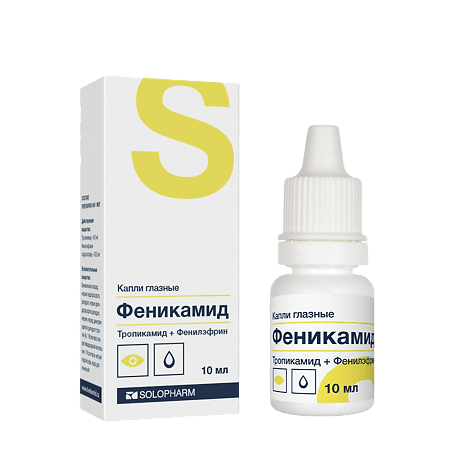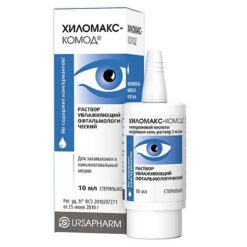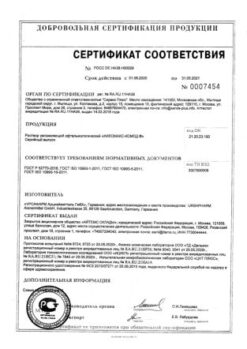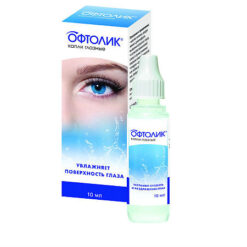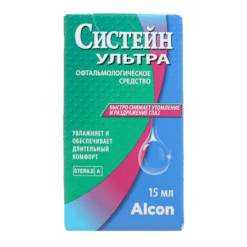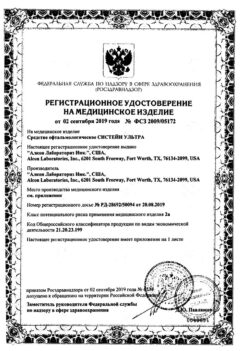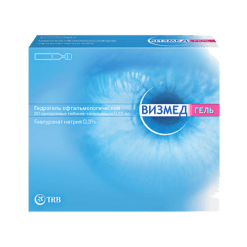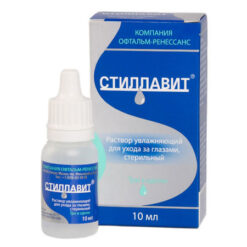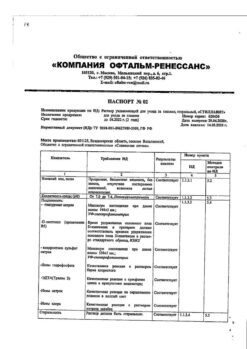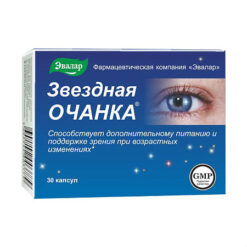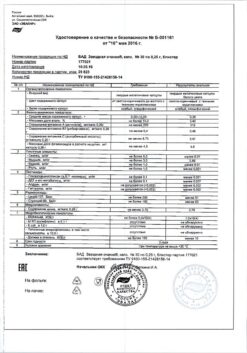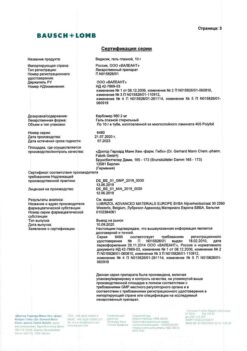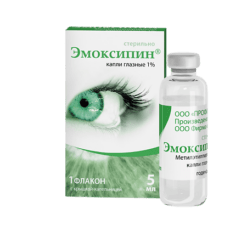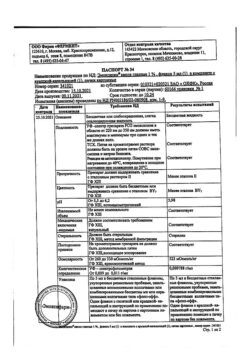No products in the cart.
Phenicamide, eye drops 8 mg/ml+50 mg/ml 10 ml
€21.95 €19.03
Description
Pharmacotherapeutic group
Ophthalmic diagnostic agent (m-cholinoblocker + alpha-adrenomimetic).
ATX code: S01FA56
Pharmacological properties
Pharmacodynamics
Tropicamide.M-cholinoblocker, blocks the m-cholinoreceptors of the pupillary sphincter and ciliary muscle, causing transient mydriasis and paralysis of accommodation. Slightly increases intraocular pressure. Mydriasis against the background of tropicamide application develops in 5-10 minutes and reaches its maximum by 20-45 minutes. Maximum pupil dilation is maintained for 1 hour and normalizes after 6 hours.
Phenylephrine.A nonselective alpha-adrenomimetic. When instilled into the eye, it causes dilation of the pupil, improves the outflow of intraocular fluid and narrows the conjunctival vessels. Phenylephrine has a pronounced stimulatory effect on postsynaptic alpha-adrenoreceptors, has a very weak effect on beta1-adrenoreceptors. It has a vasoconstrictor effect similar to that of norepinephrine (noradrenaline), while it has almost no chronotropic and inotropic effect on the heart. The vasopressor effect of phenylephrine is weaker than that of norepinephrine, but it is longer lasting. After instillation, phenylephrine contracts the dilator of the pupil and the smooth muscles of the conjunctival arterioles, thereby causing pupil dilation. Midriasis occurs within 10-60 min after a single injection and persists for 4-6 h. Phenylephrine-induced mydriasis is not accompanied by cycloplegia.
Phenylephrine complements the effects of tropicamide because their mechanisms of action are different. Phenylephrine combined with tropicamide reduces or stops tropicamide’s ability to increase intraocular pressure.
Pharmacokinetics
Tropicamide. Easily penetrates the tissues of the eye and is rapidly absorbed into the bloodstream. Using a modified radioreceptor assay, the lower limit of determination of tropicamide in plasma was less than 240 ng/mL, and the range of determination was 240 ng/mL to 10 ng/mL. The mean maximum plasma concentration at the fifth minute after injection was 2.8±1.7 ng/ml. At minute 60, the plasma concentration of tropicamide was 0.46±0.51 ng/ml and below 240 ng/ml at minute 120.
Phenylephrine.Phenylephrine readily penetrates ocular tissues, maximum plasma concentration occurs 10-20 min after topical administration. Phenylephrine is excreted by the kidneys unchanged (< 20%) or as inactive metabolites.
Indications
Indications
Used as a mydriatic agent:
for diagnostic ophthalmological procedures;
before surgical and laser operations.
Pharmacological effect
Pharmacological effect
Pharmacotherapeutic group
Diagnostic tool for ophthalmological diseases (m-anticholinergic agent + alpha-adrenergic agonist).
ATX code: S01FA56
Pharmacological properties
Pharmacodynamics
Tropicamide. M-cholinergic blocker, blocks m-cholinergic receptors of the sphincter of the pupil and ciliary muscle, causing short-term mydriasis and paralysis of accommodation. Slightly increases intraocular pressure. Mydriasis during the use of tropicamide develops after 5-10 minutes and reaches a maximum at 20-45 minutes. Maximum pupil dilation persists for 1 hour and returns to normal after 6 hours.
Phenylephrine. Non-selective alpha-adrenergic agonist. When instilled into the eye, it causes dilation of the pupil, improves the outflow of intraocular fluid and constricts the vessels of the conjunctiva. Phenylephrine has a pronounced stimulating effect on postsynaptic alpha-adrenergic receptors, but has a very weak effect on beta1-adrenergic receptors. It has a vasoconstrictor effect similar to the action of norepinephrine (norepinephrine), while it has virtually no chronotropic and inotropic effects on the heart. The vasopressor effect of phenylephrine is weaker than that of norepinephrine, but is longer lasting. After instillation, phenylephrine contracts the pupillary dilator and smooth muscle of the conjunctival arterioles, thereby causing pupillary dilation. Mydriasis occurs within 10-60 minutes after a single instillation and persists for 4-6 hours. Mydriasis caused by phenylephrine is not accompanied by cycloplegia.
Phenylephrine complements the action of tropicamide, since their mechanisms of action are different. Administration of phenylephrine together with tropicamide reduces or stops the ability of tropicamide to increase intraocular pressure.
Pharmacokinetics
Tropicamide. Easily penetrates the tissue of the eye and is quickly absorbed into the bloodstream. When using a modified radioreceptor assay, the lower limit of determination of tropicamide in plasma was less than 240 ng/ml, the detection range was 240 ng/ml – 10 ng/ml. The average maximum plasma concentration at the fifth minute after administration was 2.8 ± 1.7 ng/ml. At the 60th minute, the concentration of tropicamide in plasma was 0.46±0.51 ng/ml, and at the 120th minute it was below 240 ng/ml.
Phenylephrine. Easily penetrates the eye tissue, the maximum plasma concentration occurs 10-20 minutes after topical application. Phenylephrine is excreted by the kidneys unchanged (<20%) or in the form of inactive metabolites.
Special instructions
Special instructions
Due to a significant contraction of the pupil dilator, 30-45 minutes after instillation, pigment particles from the pigment layer of the iris may be detected in the moisture of the anterior chamber of the eye. Suspension in the chamber fluid must be differentiated from manifestations of anterior uveitis or from the ingress of blood cells into the fluid of the anterior chamber.
Benzalkonium chloride, which is often used as a preservative in ophthalmic preparations, can cause punctate keratopathy and/or toxic ulcerative keratopathy. Since the drug contains benzalkonium chloride, careful monitoring is necessary in case of frequent or prolonged use in patients with dry eye syndrome or in cases of corneal damage. Benzalkonium chloride may change the color of soft contact lenses. It is necessary to remove soft contact lenses before using the drug and put them on again 15 minutes after instillation.
Cycloplegics may increase intraocular pressure and provoke the development of angle-closure glaucoma in predisposed individuals, which must be taken into account and carefully assessed before starting treatment; Tropicamide may induce psychosis.
When using drops, avoid contact of the tip of the bottle with any surface. To reduce the risk of developing systemic side effects, it is recommended to apply light pressure with a finger on the projection area of the lacrimal sacs at the inner corner of the eye for 1-2 minutes after instillation.
Impact on the ability to drive vehicles and machinery
After using the drug, due to changes in accommodation and pupil width, visual acuity may decrease, so the use of the drug is not recommended when driving vehicles and when engaging in other potentially hazardous activities that require increased concentration and speed of psychomotor reactions.
Active ingredient
Active ingredient
Tropicamide, Phenylephrine
Composition
Composition
Composition of the drug per 1 ml:
Active ingredients:
Tropicamide 8.0 mg
Phenylephrine hydrochloride 50.0 mg
Excipients:
Benzalkonium chloride 0.1 mg
Sodium hydrogen phosphate dihydrate 0.28 mg
Sodium dihydrogen phosphate dihydrate 0.005 mg
Sodium chloride 4.5 mg
Disodium edetate dihydrate (trilon B) 0.5 mg
1 M hydrochloric acid solution or 1 M sodium hydroxide solution to pH 3.0 – 5.8
Water for injections up to 1 ml
Pregnancy
Pregnancy
The use of the drug during pregnancy and breastfeeding is contraindicated.
Contraindications
Contraindications
Hypersensitivity to any of the components, children under 18 years of age, narrow-angle and closed-angle glaucoma, mixed glaucoma, diseases of the cardiovascular system (including coronary sclerosis, angina pectoris, arrhythmia, hypertensive crisis), renal porphyria, thyrotoxicosis, type I diabetes mellitus, pregnancy, breastfeeding, simultaneous use (as well as within 3 weeks after their withdrawal) monoamine oxidase inhibitors (MAO).
With caution
Diabetes mellitus type II, old age (risk of developing ventricular arrhythmias and myocardial infarction in patients with diseases of the cardiovascular system), patients with cerebrovascular diseases, conditions after surgery (decreased healing of the conjunctiva).
Side Effects
Side Effects
Local reactions
Allergic reactions, increased intraocular pressure, transient pain, burning in the eye and photophobia, transient decreased vision, release of pigment into the aqueous humor with a temporary increase in intraocular pressure, blocking the anterior chamber angle (with narrowing of the angle), pain in the brow ridges, lacrimation, conjunctival hyperemia, keratitis; rarely – reactive miosis the next day after use (repeated instillations of the drug at this time may produce less pronounced mydriasis than the day before; this effect is more common in elderly patients).
Systemic reactions
Pale skin, dry mouth, redness and dry skin, contact dermatitis, headache, fainting, decreased blood pressure, palpitations, tachycardia and arrhythmia, bradycardia, ventricular occlusion of the coronary arteries, pulmonary embolism, central nervous system disorders and muscle rigidity, frequent urination, difficulty urination, decreased tone of the gastrointestinal tract and peristalsis, leading to constipation. Sometimes – vomiting and dizziness. In elderly patients with diseases of the cardiovascular system, ventricular arrhythmias and myocardial infarction are possible.
Interaction
Interaction
Adrenergic agonists enhance and m-cholinomimetics weaken the effect of tropicamide. Tricyclic antidepressants, phenothiazines, amantadine, quinidine, and antihistamines increase the likelihood of developing systemic side effects of tropicamide.
Atropine enhances the mydriatic effect of phenylephrine. Concomitant use with MAO inhibitors, as well as within 21 days after stopping their use, increases the risk of developing systemic adrenergic effects.
The vasopressor effect of alpha-agonists may also be enhanced when combined with tricyclic antidepressants, propranolol, guanethidine, methyldopa and m-anticholinergics. Beta blockers increase the risk of sudden increases in blood pressure. Phenylephrine increases the risk of cardiovascular depression during inhalational general anesthesia.
When prescribing beta-blockers, it is possible to enhance the vasoconstrictor effect of phenylephrine due to their suppression of vasodilation.
Due to the risk of hypertensive crisis, the combined use of phenylephrine and guanethidine, as well as any other adrenergic blocker or monoamine reuptake inhibitor, is not recommended.
Concomitant use with monoamine oxidase inhibitors and for three weeks after stopping their use increases the risk of developing systemic adrenergic effects.
The vasopressor effect of adrenergic agonists may also be enhanced when combined with tricyclic antidepressants, methyldopa and m-anticholinergics.
Pre-instillation of local anesthetics can increase systemic absorption of active substances and prolong mydriasis.
Overdose
Overdose
There are no data on overdose of tropicamide and phenylephrine when applied topically.
Symptoms (in case of accidental ingestion of the drug): dry skin and mucous membranes, hyperthermia, tachycardia, mydriasis, agitation, convulsions, coma, respiratory depression.
Treatment: gastric lavage, taking activated carbon; as an antidote – physostigmine (0.03 mg/kg intravenously slowly), benzodiazepines; to eliminate hyperthermia – cold compresses. To stop the systemic effect of phenylephrine – alpha-blockers (5-10 mg of phentolamine intravenously, repeat the injection if necessary).
Storage conditions
Storage conditions
At a temperature not exceeding 25 °C.
Keep out of the reach of children.
Shelf life
Shelf life
2 years. After opening the bottle – 1 month.
Do not use after the expiration date!
Manufacturer
Manufacturer
Grotex LLC, Russia
Additional information
| Shelf life | 2 years. After opening the bottle – 1 month. Do not use after the expiration date! |
|---|---|
| Conditions of storage | At a temperature not higher than 25 ° C. Keep out of reach of children. |
| Manufacturer | Grotex Ltd, Russia |
| Medication form | eye drops |
| Brand | Grotex Ltd |
Related products
Buy Phenicamide, eye drops 8 mg/ml+50 mg/ml 10 ml with delivery to USA, UK, Europe and over 120 other countries.

